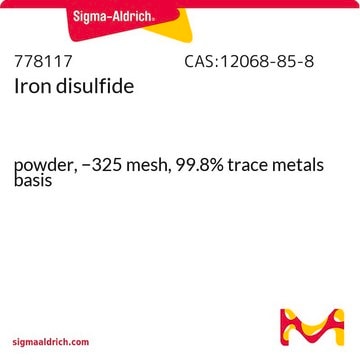343161
Iron(II) sulfide
−100 mesh, 99.9% trace metals basis
Synonyme(s) :
Ferrous sulfide
About This Item
Produits recommandés
Pureté
99.9% trace metals basis
Forme
powder
Pertinence de la réaction
reagent type: catalyst
core: iron
Taille des particules
−100 mesh
Densité
4.84 g/mL at 25 °C (lit.)
Chaîne SMILES
S=[Fe]
InChI
1S/Fe.S
Clé InChI
MBMLMWLHJBBADN-UHFFFAOYSA-N
Vous recherchez des produits similaires ? Visite Guide de comparaison des produits
Application
- Progress in bioleaching: fundamentals and mechanisms of microbial metal sulfide oxidation - part A: This study delves into the microbial oxidation of metal sulfides like Iron(II) sulfide, shedding light on bioleaching processes crucial for the extraction of valuable metals from ores, which is highly relevant for environmental and materials science applications (Vera et al., 2022).
- Novel QTL Associated with Aerenchyma-Mediated Radial Oxygen Loss (ROL) in Rice: Explores genetic traits influenced by conditions such as the presence of Iron(II) sulfide in paddy fields, providing insights into how rice adapts to iron-rich anaerobic soils, which is vital for agricultural biotechnology and crop science (Duyen et al., 2022).
- Fe(ii) and Fe(iii) dithiocarbamate complexes as single source precursors: Investigates the synthesis of nanoscale iron sulfides from these precursors, using in situ X-ray absorption spectroscopy, which is essential for developing advanced materials with specific magnetic and electronic properties (Roffey et al., 2019).
Code de la classe de stockage
11 - Combustible Solids
Classe de danger pour l'eau (WGK)
WGK 3
Point d'éclair (°F)
Not applicable
Point d'éclair (°C)
Not applicable
Certificats d'analyse (COA)
Recherchez un Certificats d'analyse (COA) en saisissant le numéro de lot du produit. Les numéros de lot figurent sur l'étiquette du produit après les mots "Lot" ou "Batch".
Déjà en possession de ce produit ?
Retrouvez la documentation relative aux produits que vous avez récemment achetés dans la Bibliothèque de documents.
Les clients ont également consulté
Notre équipe de scientifiques dispose d'une expérience dans tous les secteurs de la recherche, notamment en sciences de la vie, science des matériaux, synthèse chimique, chromatographie, analyse et dans de nombreux autres domaines..
Contacter notre Service technique









